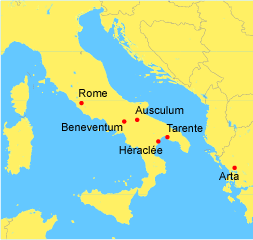Battle of Asculum
| date | 209 BC Chr. |
|---|---|
| place | Asculum in Apulla in what is now Italy |
| output | no clear result |
| Parties to the conflict | |
|---|---|
| Commander | |
| Troop strength | |
| about 20,000 | unknown |
Saguntum - Lilybaeum II - Rhone - Ticinus - Trebia - Cissa - Lake Trasimeno - Ager Falernus - Geronium - Cannae - Nola I - Nola II - Ibera - Cornus - Nola III - Beneventum I - Syracuse - Tarentum I - Capua I - Beneventum II - Silarus - Herdonia I - Upper Baetis - Capua II - Herdonia II - Numistro - Asculum - Tarentum II - New Carthage - Baecula - Grumentum - Metaurus - Ilipa - Crotona - Large fields - Cirta - Zama
The Battle of Asculum , or Battle of Canusium as it is often called, was a skirmish between Romans and Carthaginians in the Second Punic War around 209 BC. Chr . There was no clear outcome at the end of this battle .
prehistory
After the great defeats at Cannae and Lake Trasimeno, Rome invested more and more money and people in the army in order to master the Carthaginian threat. Many of the Roman men were conscripted, even slaves were sent into the field armed, so that around 210 BC. BC Rome had 21 legions. The supreme command of these armies was Quintus Fabius Maximus , a general who still tried to win the battles with outdated attack formations and open field battles. In terms of warfare, however, the Romans disagreed: Many experienced generals like Marcus Claudius Marcellus knew that Hannibal could not be defeated in an open field battle and therefore often used fortresses to achieve victories, e.g. B. in the three battles of Nola. Because of his successes so far, he was placed at the head of a 20,000-strong army, which Hannibal was now to finally defeat at Asculum.
The Roman force was divided into three parts, each under the leadership of a general: Marcus Claudius Marcellus , Quintus Fabius Maximus, or Fulvius Flaccus. A fourth army, also led by Fabus, attacked the reinforcements of Hannibal's army. Marcellus' army was now encamped at Asculum, not far from Hannibal's location. 209 BC There was a three-day battle.
The battle
Hannibal tried to pull the residents of Asculum to his side, which would have interrupted the food supply for the Roman army. The Numidians had already convinced several cities of hostility to Rome. But now the Roman troops occupied the cities in several skirmishes, whereby the Numidian garrison was almost completely wiped out. Hannibal withdrew. He ambushed Marcellus in the fields outside the city. The battle was costly and only ended when night fell.
The next day, the Carthaginians attacked at dawn: they were able to repel the left wing of the Roman army in the field battle, forcing the Romans to retreat and killing 2,700 of them. However, Hannibal refrained from pursuit.
Marcellus was not discouraged by this blow: On the third day the armies faced each other again, the Romans reinforced by newly added cavalry. The Carthaginians now had war elephants and sent them into battle. In the beginning there were the effects Hannibal wanted: the elephants caused panic in the Roman ranks. But the Roman archers succeeded in driving the elephants back, causing heavy losses to their own troops. The Romans immediately followed up with their cavalry and thus drove the Carthaginians to flight. But on the side of the Romans there were 3,000 deaths, so that Marcellus could not pursue Hannibal. The Carthaginian army withdrew and the battle was over.
consequences
The Romans did not force a victory, but they could put Hannibal on a defensive. The time of the Roman victories began, as the Carthaginian fighting spirit was almost exhausted.
Web links
- Vol. IV (s)
literature
- Peter Connolly : Hannibal and the enemies of Rome, ISBN 3-7886-0182-5 , page 83 ff
- Leonard Cottrell: Hannibal, the enemy of Rome, ISBN 978-0-03-030720-1 , p. 201 f
